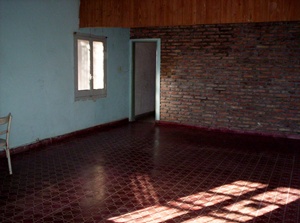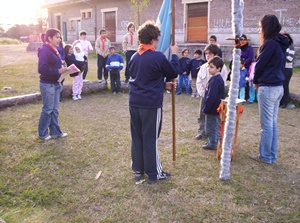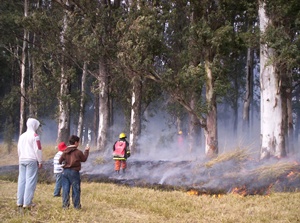Joni and I were in Buenos Aires for a couple of days last week for team meetings. San Francisco to Buenos Aires involves a night each way on a bus, and since it is the first time I have travelled with him on my own, and since the last time we took him on the night bus he yelled and screamed the whole way, I was feeling rather daunted by the prospect. However, happily to say, he was highly made up by the whole transport theme; going on a big bus, sitting upstairs and looking down on the lorries and cars and buses and even the odd train. We didn’t get a lot of sleep but it was all good humoured and we didn’t prevent anyone else from sleeping which is probably a good thing in the interests of international relationships and all.
Anyway, the photo I didn’t take… Down by the river in Buenos Aires is a stretch of road where the lorries pull over to rest. While the lorries are resting, the drivers meanwhile are “entertained” by painted women clad in scanty underwear and impossible shoes (and painted men clad in scanty women’s underwear and impossible shoes. The transvestite sex industry is bigger in Buenos Aires than anywhere else in the world. Is that a valid claim to fame?). They strut their stuff openly between the cabs. Since last time I passed this scene a large sign has been erected: “No fishing allowed, of any sort”. It’s probably bad taste, but it made me smirk.
Month: June 2009
The week in pictures
I had one of those conversations the other day… It opened thus:
“Everything OK for Tuesday?”
Me: “what about Tuesday?”
“The women’s meeting… (person) said you were going to be doing the teaching for the women’s meetings for the time being”
I really don’t mind doing the women’s meeting, I can even cope with not being consulted, but it would have been good at least to have been told… Welcome to Argentina. Thus I have initiated a series on “little known women in the Bible”, which will run either until I run out of women to talk about, or until the women of San Francisco become fed up with me and find themselves another teacher!
And thus another week has disappeared, filled with things, both expected and otherwise.
 Our stove has been installed. This is a traditional wood-burning stove known as a “salamandra”. It heats our main living area very nicely and we are both getting more adept at lighting it. Martin’s first attempt involved a litre of diesel, which was dramatically effective, if smelly. One thing we are lacking is an axe, I did manage to split a log yesterday by wedging a tea-spoon into a crevice, but it is less than ideal.
Our stove has been installed. This is a traditional wood-burning stove known as a “salamandra”. It heats our main living area very nicely and we are both getting more adept at lighting it. Martin’s first attempt involved a litre of diesel, which was dramatically effective, if smelly. One thing we are lacking is an axe, I did manage to split a log yesterday by wedging a tea-spoon into a crevice, but it is less than ideal.
 After months of faffing, the community project in the village of Quebracho Herrado looks like it might actually be going somewhere. I have driven there four days this week for different reasons. We have rented a room, which from my point of view might not have been the highest priority, but having arrived at this point, now we need to furnish it as well as working on growing relationships in the community. I had a couple of families to visit this week, except that now I also have an unplanned trip to Buenos Aires this week, so the visits will probably need to go on hold again.
After months of faffing, the community project in the village of Quebracho Herrado looks like it might actually be going somewhere. I have driven there four days this week for different reasons. We have rented a room, which from my point of view might not have been the highest priority, but having arrived at this point, now we need to furnish it as well as working on growing relationships in the community. I had a couple of families to visit this week, except that now I also have an unplanned trip to Buenos Aires this week, so the visits will probably need to go on hold again.
 I planted a little lemon sapling at home, trying to fill the spaces that are currently filled with weeds, with things that don’t need lots of looking after and might give us useful produce. Am also hoping that it might provide some shade for the herbs when it grows a bit.
I planted a little lemon sapling at home, trying to fill the spaces that are currently filled with weeds, with things that don’t need lots of looking after and might give us useful produce. Am also hoping that it might provide some shade for the herbs when it grows a bit.
 While Guides are rather thin on the ground in Argentina, (although they do exist), Scouts on the other hand are quite plentiful; there are three units that I know of in San Francisco, and these days they are all mixed gender anyway. In Argentina the Scout association is strongly linked with the Catholic church, which personally I wouldn’t have a problem working with, but it might have caused me to be cast into the outer darkness by some non-Catholic Christians around here. Fortunately, one of the groups here in San Fran is not directly affiliated to any church, so I made myself known to them and was invited to join. On my second week I found myself in charge of a cub-pack, which was a bit hairy since I don’t yet know the kids’ names. Luckily there were some stray venture scouts (called Caminantes) kicking around, who came and gave me a hand, and we all survived to tell the tale.
While Guides are rather thin on the ground in Argentina, (although they do exist), Scouts on the other hand are quite plentiful; there are three units that I know of in San Francisco, and these days they are all mixed gender anyway. In Argentina the Scout association is strongly linked with the Catholic church, which personally I wouldn’t have a problem working with, but it might have caused me to be cast into the outer darkness by some non-Catholic Christians around here. Fortunately, one of the groups here in San Fran is not directly affiliated to any church, so I made myself known to them and was invited to join. On my second week I found myself in charge of a cub-pack, which was a bit hairy since I don’t yet know the kids’ names. Luckily there were some stray venture scouts (called Caminantes) kicking around, who came and gave me a hand, and we all survived to tell the tale.
 The last few days we have been entertaining Megan from Scotland, who has been doing her university language year in Cordoba. Today we went out touristing to a little place called Arroyito, whose main claim to fame is that it is the original home of “Arcor”, one of the biggest producers of chocolate in Argentina. It also has a nice river for walking and chilling out, and today we also watched the fire-brigade putting out a minor bush-fire near the river bank; there has been a drought for nearly a year here in Cordoba, things are pretty dry. Joni liked the fire engine, he has been practicing saying “nee-nor” to the pictures his Fireman Sam book!
The last few days we have been entertaining Megan from Scotland, who has been doing her university language year in Cordoba. Today we went out touristing to a little place called Arroyito, whose main claim to fame is that it is the original home of “Arcor”, one of the biggest producers of chocolate in Argentina. It also has a nice river for walking and chilling out, and today we also watched the fire-brigade putting out a minor bush-fire near the river bank; there has been a drought for nearly a year here in Cordoba, things are pretty dry. Joni liked the fire engine, he has been practicing saying “nee-nor” to the pictures his Fireman Sam book!
The body of Christ has Downs Syndrome
Someone sent me a bunch of articles on practical theology which I am ploughing my way through in idle moments. The other day I was reading one by John Swinton (2003 Journal of Pastoral Theology) called “The Body of Christ has Down’s Syndrome”, in which he quotes a care worker as saying “I sometimes wonder if Jesus had Down ’s syndrome”.
When it came down to it, neither Swinton nor the careworker went on dogmatically to defend their hypothesis, if only because probability is stacked against them. But it is interesting to think that if a film-maker portrayed Jesus as having Down’s syndrome (to give but one example) it would definitely cause a reaction, be it positive or negative, and it would be most likely referred to by the critics as “making a statement”. Conversely, when Jesus is shown as being blonde and blue eyed, as in the film we endured enjoyed the other week, no-one bats an eye lid, even though statistically it is even less likely that Jesus was blonde than that he had Down’s syndrome. This portrayal of Jesus becomes even more questionable in the light of passages such as Isaiah 53 which suggest that Jesus had nothing striking about his appearance, and Mark 6 where they ask “Isn’t that the carpenter?” i.e. where did this common or garden bloke get this teaching from? The fact that scripture tells us virtually nothing about Jesus’ appearance means that we have to guess that he was probably quite similar to the people around him, so while he was unlikely to have had Down’s syndrome, he definitely wasn’t blonde.
I think this relates to something that Francis Young would refer to as the “idolization of Jesus” which when I first read that phrase I thought it was a strange concept, and I thought she was about to try and tell me why Jesus wasn’t really God or why he shouldn’t really be worshipped, but actually she went on to talk about how we create a false idol out of the real God. I suspect our reaction to “the Jesus with Down’s syndrome” compared with our non-reaction to “the blonde Jesus” is about our idolization of him, that it is OK (in our minds at least) to tell lies about Jesus as long as our fictitious image of him is one which is recognised as positive by our own society. The net result of which is that we prevent Jesus from challenging our stereotypes by ensuring that our “graven image” of him fits right into them.
Mama Mía
Mama Mía but it’s cold. At this moment it is 4 degrees both outside and in. Our house is huge and wonderful and versatile and unheated. We have just bought a gas heater and a wood-burning stove, but they both need installing. This may happen tomorrow. In the meantime we are wearing three jumpers each, and sleeping in thermal underwear.
Meanwhile, our child has learned how to say “mine”. Actually he says it in Spanish “mío”. Things he has designated as his include all mobile phones in the universe, all the lollypops, particular any that are already in other kids’ mouths, all the footballs, the swimming pool where we go a couple of times a week (“pool mío”), the car keys, daddy’s glasses, daddy himself (“daddy mío”) and the little girl who lives round the corner (“Abeeeee mío”). Her usual name is Abril, she’s nine years old and Joni adores her. She and her little mates quite often come round and borrow him to go and play on the swings in the plaza just across the road from us. It’s a fine arrangement; Joni gets to go to the park, the girls get a “walking talking living doll” to play with, and we enjoy a few minutes’ peace while still being able to eye-ball them all from out of the window. Everyone’s a winner.